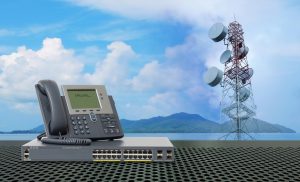Are you prepared for POTS line replacement?
First, what is POTS? POTS stands for Plain Old Telephone Service, meaning analog copper phone lines. It’s a voice transmission phone system that has been around for decades, that evolved from an earlier system invented in the 1880s. POTS was cutting edge when it was initially invented, but today the world has seen development of far faster, more flexible, and cost-effective technology as an alternative to POTS.
Some examples of devices that run on these older analog lines are voice lines, fax lines, fire alarms, burglary alarms, elevators, gate entry systems, Point of Sale (PoS), VoIP back-ups, and more. Many phone lines have been changed over to VoIP (Voice over Internet Protocol) but may still use a back-up POTS line.
In 2010, the FCC mandated that POTS be phased out by August 2, 2022. Due to the impending deadline of this mandate, major carriers like Verizon and AT&T are planning to “sunset” POTS lines by dropping support for the copper lines or raising prices dramatically for lines that are not replaced. FCC reports the number of POTS lines in the U.S. declined from 122 million in 2010 to about 36 million in 2021.
POTS being phased out means that any business that has not already transitioned away from analog and to a digital solution will have to do so. Businesses that do not make the August deadline may face a costly replacement process, or face POTS line costs that are double or triple current per-line costs since providers are not investing in these older networks any longer.

How do I approach a POTS replacement initiative?
1- The first step to take is to assess if you currently utilize POTS lines, and if so, how many. Many facilities have multiple POTS lines for fire, security, and more. If your business has multiple locations, local service providers may have different timelines for sunsetting POTS, so be sure to check locally and see what the planning looks like. You also need to plan for any service interruptions that may arise from removing your POTS lines, e.g., a security alarm that can call 911 in case of an emergency.
2- Once you know how many POTS lines need to be replaced, then you can begin to evaluate replacement options. The two most common options are Wireless or VoIP. There are already several vendors offering comprehensive POTS line replacement, so it is just a matter of finding which vendor suits your needs and budget.
3- If you don’t have a POTS replacement plan right now, there is still plenty of time to plan for POTS line replacement for your enterprise. Working with an experienced provider that can help sort through the best solutions based on your company’s needs is key.
What are the advantages of the POTS replacement lines?
The advantages of moving away from old landline and analog lines to digital lines seem pretty straightforward and include:
– Lower Operating Costs– while some companies may think upgrading to newer digital equipment will be costly, the opposite is actually true. Businesses that use landline services typically pay much higher monthly service costs including costs for on-site servers, an IT staff to manage it all, replacing outdated hardware and the list goes on. A fully managed LTE network is actually much less expensive than traditional landlines.
– Better Reliability and Business Continuity– switching over from analog to a digital network provides the redundancy needed in networks. No more loss of service due to cut lines or service interruptions due to older hardware. The network is always on and keeps your business running.
– A Single Device Can Replace Multiple POTS Lines- today’s newer solutions enable multiple combinations of legacy analog wire-line services to be carried over flexible combinations of WAN/LAN/LTE Cellular Data Networks. These Include: in-band Voice, Machine to Machine (M2M) Data, DTMF signaling tones, analog data modem tones, FAX and Alarm system signals all previously connected to the Public Switched Telephone Network [PSTN].
In summary, replacing your POTS lines is not an optional project. Rising costs for legacy POTS lines will continue to justify the project while service improvements from replacement options further warrant replacing old analog lines.
Contact OVATION to discuss project support capabilities and best practices when planning for an executing your POTS replacement strategy. Since 2002, OVATION has been guiding enterprises with professional and managed services that result in successful and cost-effective programs for their wireless connected devices.



